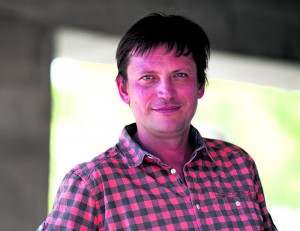Sunday | 21. July. 2013
Inspired by old hits
Conversation: Dalibor Matanić, screenwriter and director of the film Handymen
We deliberately went for the retro version in everything, with a general idea to show that our characters are stuck in time in a certain way.
After seeing your Fine Dead Girls, The Lika Cinema, Mother of Asphalt, Daddy, and other films, we expect from you dark films with an unpleasant taste. However, Handymen is an unexpectedly spirited film, a comedy that, to put it that way, goes along the lines of your feature length debut The Cashier Wants to Go to the Seaside.
The film Mezzanine is to blame, my short film from two years ago, the third part of the omnibus 6/6, that had been slowly developing since 2002. When I saw Mezzanine I thought: “It does not get darker than this. It’s time for a comedy.” This was a turning point for me to start tackling the same problems in a lighter manner. In any case, now it seems to me that this is a more accurate approach to reality.
There are a lot of gags and physical humour, which is not common for Croatian film.
Comedy is really the most difficult genre for a director. In terms of physical humour, this was the first time that I had a choreographer on a film. I engaged Irma Omerzo, with whom I collaborated in theatre on the production of Fine Dead Girls. We had an excellent working relationship. With her help we dealt with delicate details, we examined things; we searched for a gag that would be funny without being exaggerated. Actually, gag as a caricature has to be exaggerated, but we tried to avoid this gag humour becoming an end in itself, becoming isolated, forcing laughter. We wanted it to fit into the plot and the story. We wanted it to be casual, of course, to the highest extent possible. Before starting shooting I examined some films with this particular comedy note, such as The Party by Blake Edwards or films by genial Billy Wilder. I quote them at times in Handymen and some might recognize the quotes. I could not resist having the chase around the table scene, which is, of course, homage to Golik’s One Song a Day Takes Mischief Away. Working with a choreographer on more complex movements, actors felt more at ease. They felt they were in safe hands and they could work on their fine points.
The time in which the film is set is rather indefinite. References on the collapse of the railway evoke present time. However, there are no modern devices, such as mobile phones, and most of the technology – cars, radios, cassette players – and songs seem like resurrections from the dustbin of history.
We deliberately went for the retro version in everything, with a general idea to show that our characters are stuck in time in a certain way, although they are trying to be in the present, that would be – summing it all – the so-called real time of action. We could say that there is a trace of irony toward the present, the kind that I like in the films by Aki Kaurismaki.
Your excellent working relationship with director of photography Vanja Černjul is very noticeable.
We understand each other easily and I think he finds it enjoyable to come to Croatia and make a film in an atmosphere different from that in America, where he lives and works. For example, in this film, among other things, his American experience with working with actors was very useful. He knew how to subordinate the overall photography to the actor, without neglecting everything else.
The film is loaded with Croatian old popular melodies. Did you develop part of the screenplay according to those songs?
To an extent. During the shooting phase we knew the soundtracks for individual scenes and this was helpful to actors and even to Vanja Černjul. Looking from that angle, it was great that the film was produced by Croatian Radiotelevision because it was easier to get hold of these songs and to get a permission to use them.
By Janko Heidl



